This year’s Giro starts with three stages in the Netherlands
The Giro d’Italia has started on foreign soil every second year since 2010 (any many times before that) and the tradition continues in 2016 with the first three stages being held in The Netherlands.
The race opens with a flat, 9.8km individual time trial around the city of Apeldoorn before two similarly flat, sprinter-friendly road stages through the surrounding countryside. Then it’s time for the first of three rest days and a long transfer to Italy.
After a rest day, the race continues in southern Italy before making its way north
Back on home soil for the start of stage 4, the race resumes in the city of Catanzaro on the southern tip of the Italian mainland. Over the following two weeks the race will cover the length of Italy, heading towards the north eastern corner of the country.
In the final week the race swings west, towards and briefly into France, before looping back around to finish in Torino.
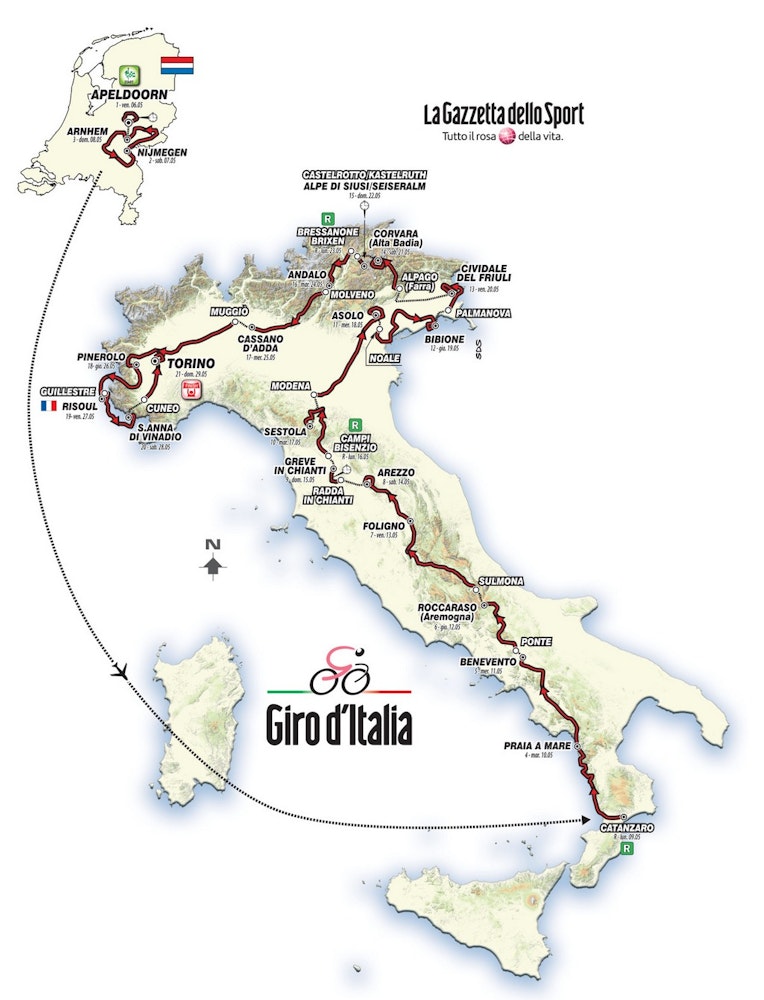
As you would expect, the first half of the Giro is considerably easier than the second, but it’s not without its challenges. Stage 6 features the race’s first uphill finish — a nearly 20km climb to Roccaraso (Aremogna) — there’s a long and lumpy individual time trial on stage 9, and then stage 10 finishes with a 16km climb, a short descent and a 7.5km climb.
But it’s in the second and third weeks of the race that things start to get really tough. Stages 13, 14, and 16 are all high mountain stages with plenty of climbing, stage 15 is an all-uphill individual time trial, and stages 19 and 20 also feature uphill finishes.
As has become the norm, the final stage into Torino will be a largely processional sprint stage, but all riders will have earned an easier day by that point.
Click through to The Inner Ring for a stage-by-stage breakdown of the race.
There are three individual time trials and five summit finishes to shape the general classification
The stage 1 time trial in Appeldorn will decide who gets to wear the first maglia rosa of this year’s Giro d’Italia and, in turn, who might be in pink when the race reaches Italy for the start of stage 4. But that opening stage is likely to mean little in the battle for the race overall – there are plenty of stages later on to do that.
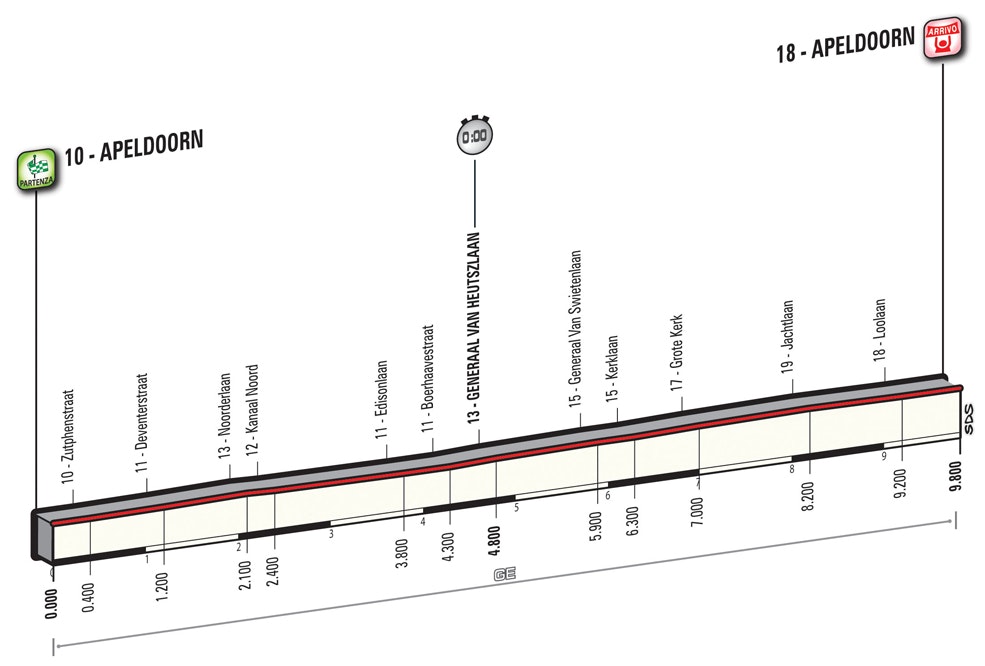
The stage 1 ITT is as about flat as you’re likely to see. One for the pure time-trialists.
The stage 9 ITT takes the riders through the famous Chianti wine region and is likely to play an important role in shaping the GC. It’s a touch over 40km and is far from flat — there’s one 5km ascent of about 4% — making it a stage the big favourites might factor in.
The stage 15 uphill time trial should be even more decisive. It’s 10.9km long with most of it being at a gradient of more than 8%. With this stage falling just before the final rest day, expect the GC favourites to give it everything to ensure they’re in a strong position for the final six stages.
And speaking of the final six stages, this is where we’ll find two of the race’s hardest days. Stage 19 features more than 3,500m of climbing, including the race’s highest point (the Cima Coppi) in the 2,744m Colle dell’Agenllo. The stage then finishes with an 11km climb to Risoul, France.
Stage 20 is arguably even more difficult. With three big climbs, a 2.5km rise to the finish, and a total of more than 4,300m of climbing, this is an exceptionally hard way to end the race’s visit to the Alps.
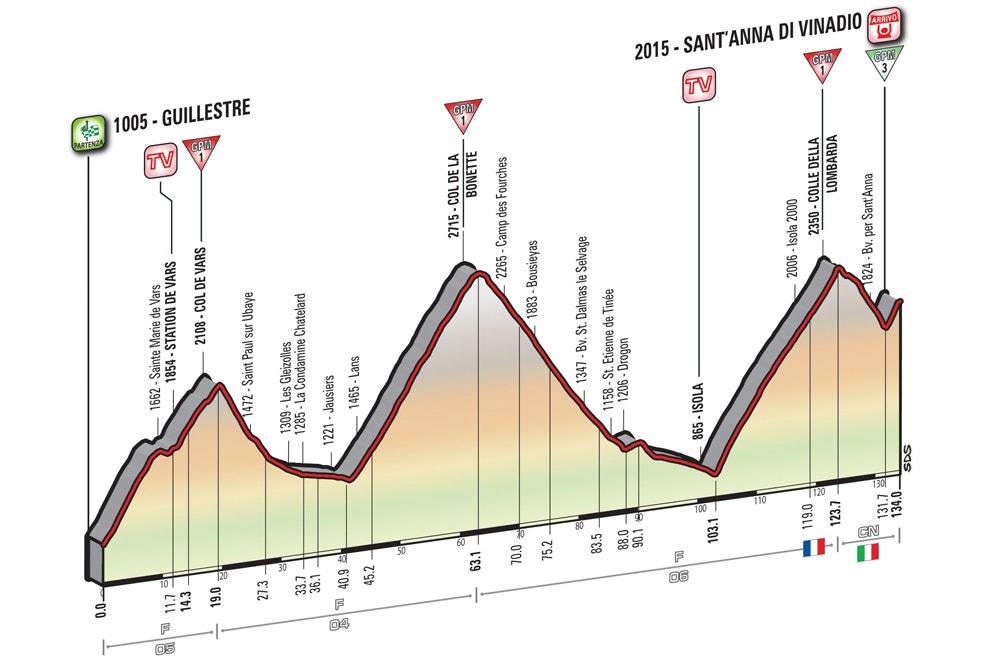
Stage 20: the final day in the mountains.
In all there are seven high-mountain stages, four medium-mountain stages and a total of five uphill finishes. Add the individual time trials to that and there are plenty of opportunities for the general classification to be won and lost.
There are perhaps four main favourites for the race overall
Defending champion Alberto Contador (Tinkoff) is skipping the Giro this year, as too is 2014 winner Nairo Quintana (Movistar). In fact, just one of the so-called ‘Big Four’ will be on the startline: Vincenzo Nibali (Astana).
Nibali is perhaps the most likely to reach Torino atop the general classification. Were he to do so it would be his second Giro d’Italia title after dominating in 2013 with three stage wins and a final margin of nearly five minutes.
At his best, Nibali is a formidable climber and impressive against the clock. In 2013 he took the overall lead with fourth in the long stage 8 ITT and lead for the rest of the race, padding his lead along the way with victories in the uphill time trial on stage 18 and summit finish on stage 20 (see video below). Could a repeat performance be on the cards three years later?
Nibali has shown flashes of form this year, winning the Tour of Oman back in February, but he seems to be a little behind where he was in 2013. That year he won Tirreno-Adriatico and the Giro del Trentino as part of an impressive Giro build-up. But even if he’s a little off his best when he starts this year’s race, Vincenzo Nibali will almost certainly improve throughout the three weeks and will be difficult to beat.
Nibali’s former teammate Mikel Landa (Sky) will also start among the favourites. The Basque rider won two stages and finished third overall in last year’s Giro, while ostensibly riding in support of Fabio Aru (who finished second). Now that he’s the outright leader, with a strong Sky squad behind him, Landa is a genuine threat.
He’s started the year well with a stage win at the Vuelta al Pais Vasco plus a stage win and the overall at the traditional lead-up race, the Giro del Trentino. Expect Mikel Landa to be with or ahead of the other main favourites when the road tilts up late in the final week.
It’s amazing to think that Alejandro Valverde (Movistar) is now in his 16th season as a pro and yet he’s never ridden the Giro d’Italia. He’ll break that drought this month and he’s a genuine chance to win on debut.
Almost certainly the most versatile rider of his generation, Alejandro Valverde is a proven winner in big one-day races (3 x Liege-Bastogne-Liege and 4 x Fleche Wallonne, just for starters) and at the Grand Tours. He won the Vuelta a Espana in 2009 and other than a DNF in his first appearance there, his overall results are: third, fourth, second, fifth, first, second, third, third and seventh.
It’s an extraordinary record (not to mention his nine stage wins) and with five top-10s and four stage victories at the Tour de France as well, there’s no doubt Valverde is a genuine contender when it comes to Grand Tours.
As with all the big GC threats, the Spaniard climbs very well and time trials very well. Barring accident or illness, it’s hard not see Alejandro Valverde on the Giro podium come Torino.
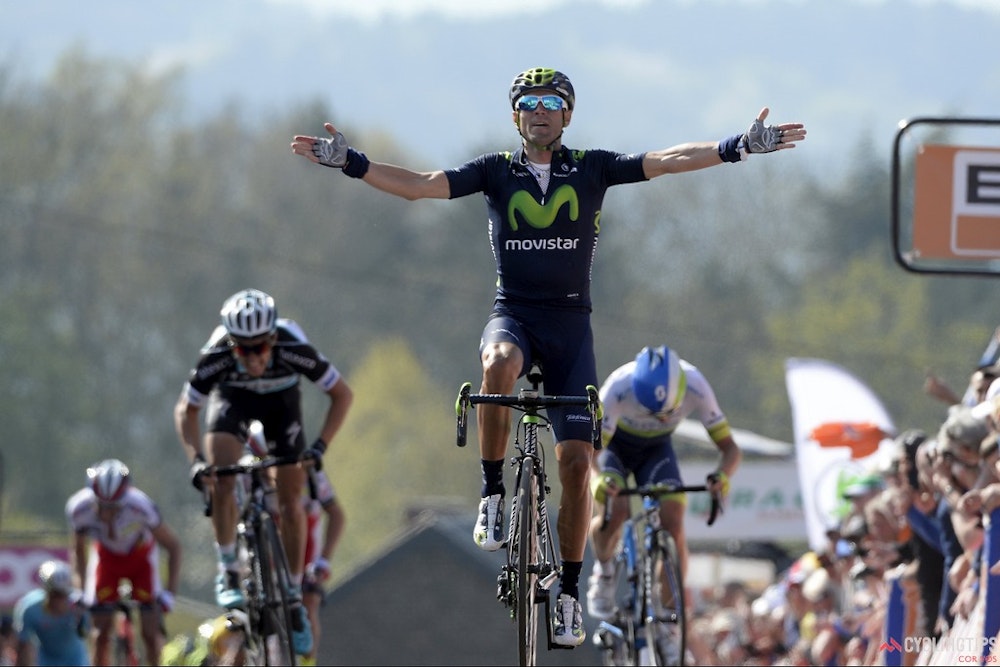
Arguably the most well-rounded rider in the world, Alejandro Valverde is a genuine threat in his first Giro.
The fourth of the big favourites for the race is Rigoberto Uran. Cannondale has made no secret of the fact that the Giro is the team’s big goal for the year and that ‘Rigo’ is the rider they’ll be backing. And he’s a good rider to back: the Colombian’s finished second overall at the Giro on two occasions — in 2013 and 2014 — and both times he won a stage. In 2013 he won on a long uphill finish and in 2014 he won a long, lumpy time trial — one not dissimilar to the one the riders will face on stage 9 this year.
In short, Uran is a very versatile rider that’s strong uphill and against the clock, and he’s a chance for a strong result in this year’s race. He perhaps hasn’t shown the sort of form this season that the other big favourites have — he’s yet to win in 2016 — but the same was true when he finished second in both 2013 and 2014.
Beyond the big favourites there are several other riders well worthy of attention
While the overall winner (and possibly even the entire podium) is likely to come from the four riders above, there are a number of others that really shouldn’t be discounted.
Esteban Chaves (Orica-GreenEdge) had a breakout year in 2015, winning two stages of the Vuelta a Espana (see video below) en route to fifth overall, and a stage plus the overall at the Abu Dhabi Tour. The ebullient Colombian has had a modest start to the year but with his strength in the hills and an Orica-GreenEdge climbing squad that’s been bolstered this year, Chaves should be in the mix.
One rider that Chaves battled throughout last year’s Vuelta was Tom Dumoulin (Giant-Alpecin). The Dutchman’s team has said he’ll be focused mainly on the time trials at this year’s race and it would be fitting for Dumoulin to win the stage 1 ITT on home soil (particularly after missing out in Utrecht in last year’s Tour). He’ll have some stuff competition in Fabian Cancellara (Trek-Segafredo) and others, but will likely be the favourite for that stage. He should also be one to watch on the stage 9 ITT but whether that will translate to a good GC performance remains to be seen.
Ilnur Zakarin (Katusha) won a stage in last year’s Giro after winning the Tour de Romandie and he’s on a similar path again this year. He won a stage at Paris-Nice and crossed the line first on one stage of the Tour de Romandie but was later relegated. The Russian is unlikely to win the race overall but he’s almost certainly going to have an impact and could find himself inside the top 10 come race’s end.
One of the true lowlights of last year’s Giro was Domenico Pozzovivo’s sickening crash on stage 3. It was a crash that, thankfully, wasn’t as bad as it first looked, but it did rule the diminutive Italian out of the rest of the race. Pozzovivo won’t win the Giro, but he’s one of the purest climbers in the race and can be expected to feature whenever the road tilts skyward.
Marcel Kittel is probably the sprinter to beat, but he will have a whole lot of competition
There are six stages at this year’s Giro d’Italia that are likely to end in a bunch sprint — stages 2, 3, 7, 12, 17 and 21 — and another three that might also, if the conditions are right — stages 4, 5 and 11. That’s quite a few opportunities for the sprinters in amongst all the climbing and time trialling.
A look at the startlist suggests that two-time Giro stage winner Marcel Kittel (Etixx-QuickStep) will be the favourite for the pure sprint stages. After a horrible year last year, the big German is back to his best in 2016 with eight wins already: two stages and the overall at the Dubai Tour, two stages at the Volta ao Algarve, a stage at Three Days of De Panne, Scheldeprijs, and a stage of the Tour de Romandie.
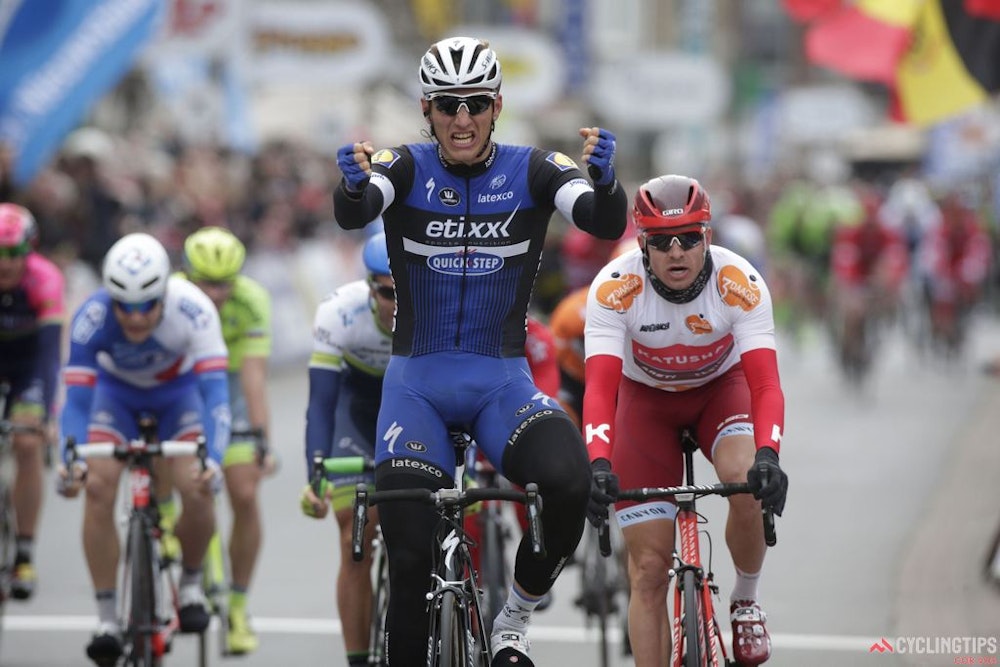
Marcel Kittel is back to his winning ways in 2016 and will the sprinter to beat in the Giro’s flat finishes.
Kittel’s biggest rival is likely to be his compatriot Andre Greipel (Lotto Soudal). Greipel’s hit the winners’ list three times in 2016 so far — including at the Tour of Turkey last week — and he’ll be keen to add to the stage win he took in last year’s Giro.
Beyond the two Germans there’s a huge host of riders that will be battling for stage glory. Elia Viviani (Sky) will be keen to win again on home soil, as too will Sacha Modolo (Lampre-Merida) who is coming off two stage wins at the Tour of Turkey. Giacomo Nizzolo (Trek-Segafredo) is in similarly good form, having won twice at the Tour of Croatia. Sonny Colbrelli (Bardiani-CSF) is always in with a chance, as too is young Dutchman Moreno Hofland (LottoNL-Jumbo).
But perhaps the sprinters that will be most interesting to watch will be young guns Caleb Ewan (Orica-GreenEdge) and Jakub Mareczko (Wilier-Southeast). Twenty-one-year-old Ewan took his first Grand Tour win at last year’s Vuelta, beating John Degenkolb and Peter Sagan. It will be fascinating to see how he goes against “pure” sprinters like Kittel and Greipel.
The same applies for 22-year-old Mareczko who, like Ewan and Fernando Gaviria, is one of the most exciting young sprinters in the world. The Italian made headlines last year when he won an incredible seven of nine stages at the 2.1 Tour of Taihu Lake and he has five wins already this year (stages at the Tour de San Luis, Tour de Langkawki, Coppi e Bartali and two at the Tour of Turkey). It will be very interesting to see how he fares in his first Grand Tour.
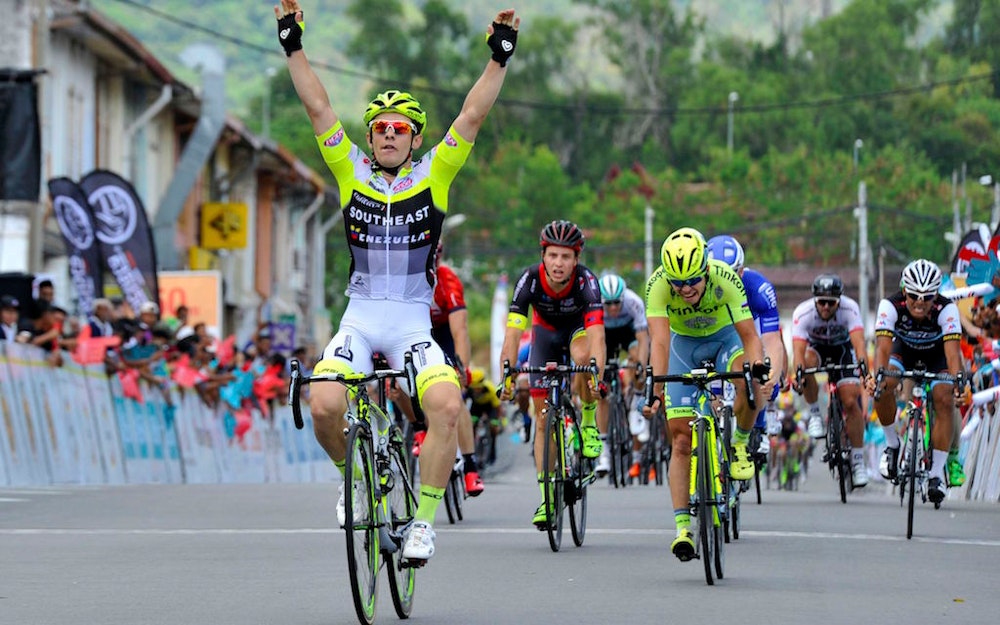
Jakub Mareczko has been doing lots of this in the past couple seasons.
There will be plenty of chances for the opportunists to win a stage
While certain stages seem likely to end in a bunch sprint, and others seem to be fodder for the GC contenders, nothing’s certain in a race like the Giro. Just look at stage 10 of last year’s race, a stage that was as close to a pure sprint stage as you’re likely to get but was won by Nicola Boem (Bardiani-CSF) from the breakaway.
Add to that the stages that seem to suit a breakaway and/or a late escape and there’s no shortage of opportunities for riders of all abilities to win a stage of the Giro. Late climbs on stage 8, stage 11 and stage 18 could make for particularly interesting finishes.
While the list of contenders will change from stage to stage, there are some riders that can be counted on to liven up this year’s Giro.
Rafal Majka goes in as leader of the Tinkoff squad and after finishing sixth and seventh in 2014 and 2013 respectively, it’s no surprise he has GC ambitions. Regardless of how he goes with that goal, you can expect the Pole to go on the attack in the mountains. He’s taken three Tour de France summit finish stage wins in the past two years — including to Risoul in 2014, where the Giro goes on stage 19 — and definitely shouldn’t be discounted in the mountains this month.
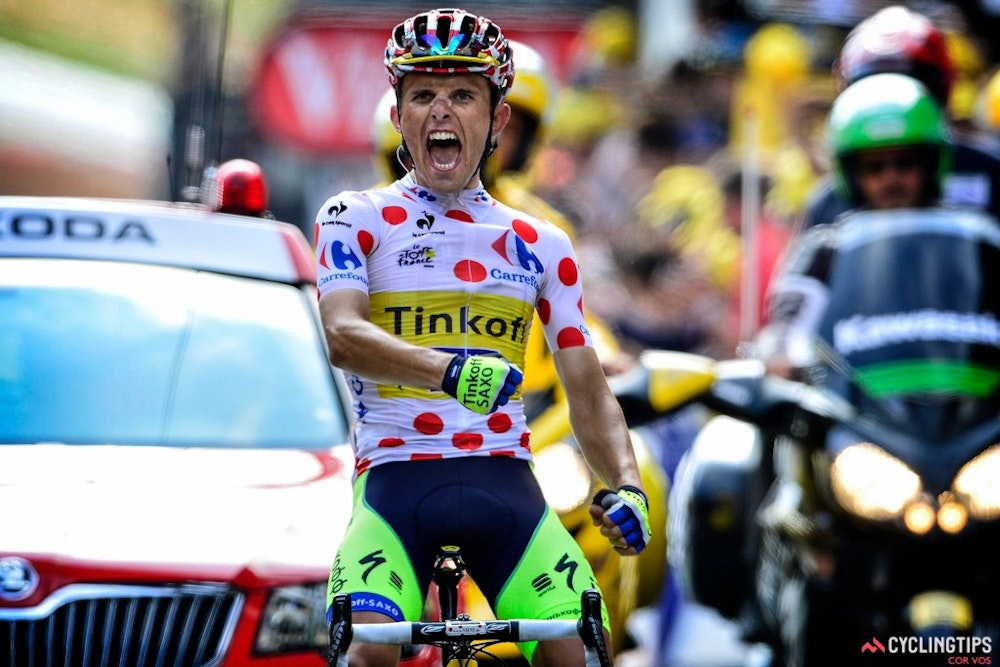
Rafal Majka loves hard mountain stages and will be one to watch again in this year’s Giro.
Ruben Plaza has a new home at Orica-GreenEdge and when he’s not looking after Esteban Chaves, he can be expected to go on the attack. He won a stage at the Tour and the Vuelta last year in such fashion.
Tim Wellens (Lotto Soudal), Nicolas Roche (Sky), Giovanni Visconti (Movistar), Bob Jungels (Etixx-QuickStep) and Alessandro De Marchi (BMC) are just some of the riders who also enjoy getting away from the bunch, as too is Steven Kruijswijk (LottoNL-Jumbo) who was one of the most consistent and impressive riders in last year’s race not to get a stage win.
There are six must-watch stages in this year’s race
Most of us would love to sit down and watch every stage of the Giro d’Italia but it’s often not possible, particularly for those of us in the Southern Hemisphere. With that in mind, here are the stages you should definitely try to watch:
Stage 6: The first uphill finish of the race and the first opportunity for the GC contenders to test their legs.
Stage 8: This stage features a steep, 10km climb just before the finish, 6km of which is unsealed. The last kilometre, too, is uphill, taking the riders through the cobbled streets of Arezzo.
Stage 14: A truly epic stage in the Dolomites with six ascents and more than 5,300m of climbing!
Stage 15: The uphill individual time trial. Should shape the GC.
Stage 19: Features two monster climbs: the Cima Coppi and the uphill finish to Risoul.
Stage 20: A short stage at 134km but with three big climbs (the first straight out of the neutral zone) and a 2.5km ramp to the finish, it’s sure to be an exciting stage.
Australian fans can catch every stage of the Giro d’Italia live on SBS TV and streaming via the Cycling Central website. The race will also be live everyday on Eurosport (Foxtel channel 511).
If you’re in the U.S. your best option is online streaming via beIN Sports while fans in the UK and Europe are serviced by Eurosport, host broadcaster RAI and Sporza. As ever, be sure to check your local guides for day-to-day broadcast details.
If you’re following the race on Twitter, the hashtag you’ll need is #Giro.
So who do you think will win the 2016 Giro d’Italia? And how will they do it?
This article was originally published on cyclingtips.com





